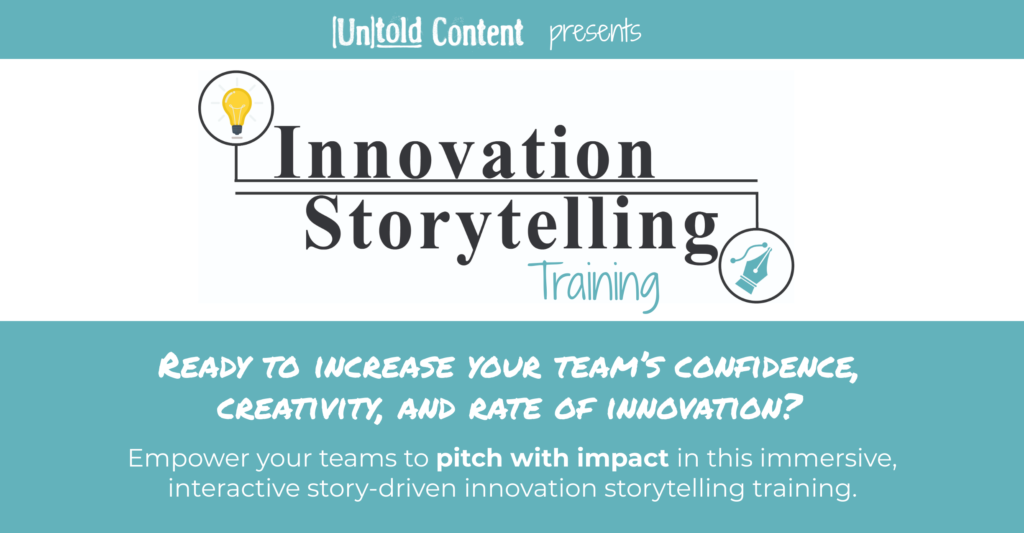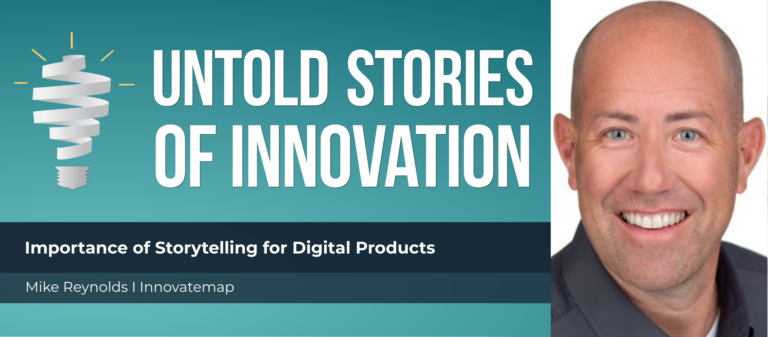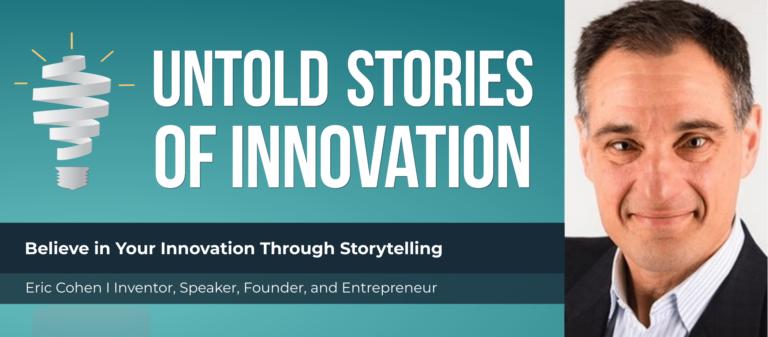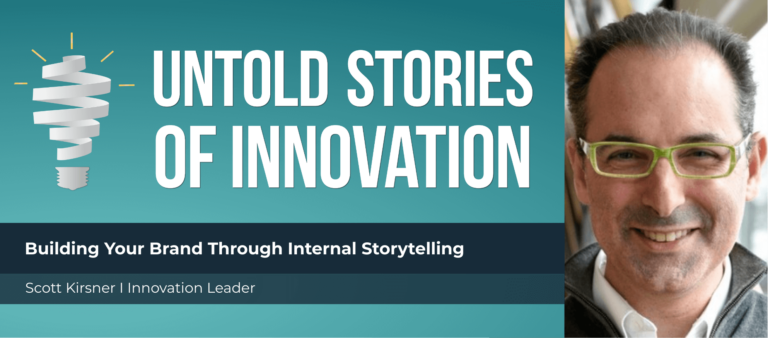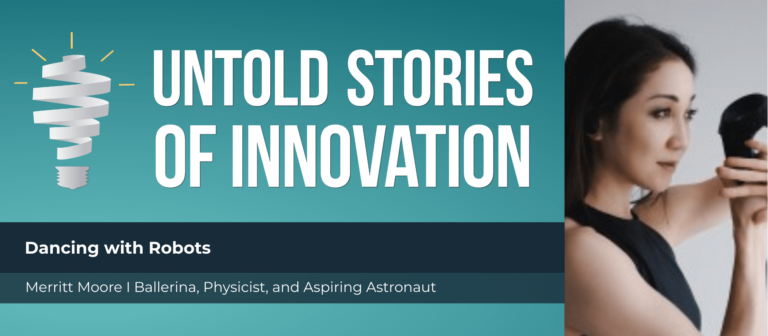Believe in Your Innovation with Eric Cohen
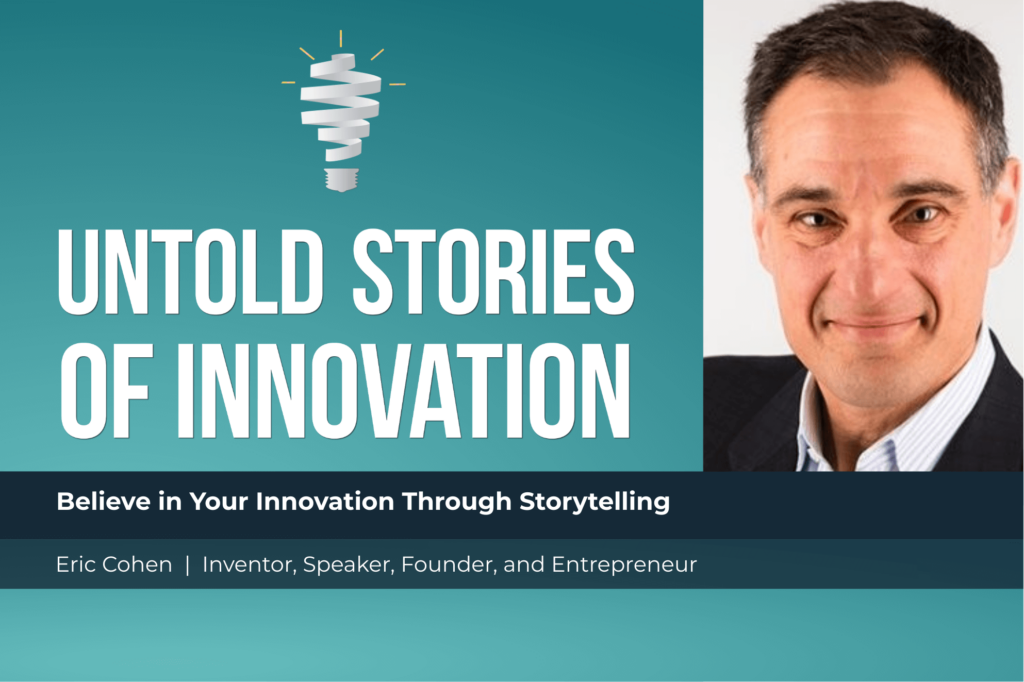
Believe In Your Innovation - Untold Innovation Stories
“I can see companies need to be able to tell stories better. It's not just reserved for the brand and marketing groups. Everyone needs to be able to tell a story to sell an idea.” — Eric Cohen
From today’s episode you’ll learn:
Why do stories matter to the innovation process? What values can be instilled in innovators who share stories? How do innovation leaders inspire creators to tell and share their success and failure stories? Believe in your innovation!
We speak with Eric Cohen, CEO, Entrepreneur, Speaker, Award-winning Inventor of the Reebok PUMP, Technologist, Mentor, Innovator in Consumer, CPG, and Healthcare. We discuss the issue with an innovation that does not have a story. If your innovation falls flat at first, you craft a compelling innovation story and fight for an innovation that you know has an audience by getting to know how to communicate with that audience. Eric shares how even a successful innovation like Swiffer needs a good innovation story, and how no matter what sector your innovation is in, you too can really connect with your audience.

Eric Cohen invented the Reebok Pump and has helped launch well-known products for brands such as Swiffer, Pampers, Target, Pepsi, Johnson & Johnson, and Giro. Eric is a recognized leader and speaker in consumer and health technology with more than 30 years of experience developing products that involve new technologies to enable highly relevant consumer experiences. He has served as an expert witness on patent infringement cases and been quoted in American Public Radio, USA Today, and ESPN sports for his opinions about new products and technology. Eric is also a competitive cyclist, photographer, and holds a degree in mechanical engineering.
This episode is powered by Untold Content’s innovation storytelling training. Increase buy in for your best ideas in this immersive and interactive, story-driven experience. Where your teams refine storytelling techniques for their latest projects, prototypes and pitches—and get inspired by 25 epic examples of impactful innovation stories. Learn more at untoldcontent.com/trainings/innovation-storytelling-training
Katie Trauth Taylor [00:00:04] Welcome to Untold Stories of Innovation, where we amplify untold stories of insight, impact and innovation powered by Untold Content. I’m your host, Katie Trauth Taylor. My guest today is Eric Cohen. He is actually the inventor of the Reebok pump and has helped launch well-known products for brands such as Swiffer, Pampers, Target, Pepsi, Johnson and Johnson, and Girot. Eric is a recognized leader and speaker in consumer and health technology with more than 30 years of experience in developing products that involve new technologies to enable highly relevant consumer experiences. I cannot wait for you to hear some of Eric’s innovation stories. Eric, thank you so much for being on the podcast.
Eric Cohen [00:00:51] Hi, Katie. Thanks so much for having me.
Katie Trauth Taylor [00:00:53] I love your personal story of innovation because you actually started out as a mechanical engineer, right?
Eric Cohen [00:00:59] I am through and through. I was one of those kids that took apart everything in the house and tried to put it back together. It was starting at about five years old, not always successful, but I always gave it a try.
Katie Trauth Taylor [00:01:11] I love that. So, you know, one of my favorite stories that you and I were able to chat a little bit before we started recording this, and I feel like we just… we have to tell the story of the Reebok pump again. It’s that process of taking things apart, putting them back together, seeing things from different angles. Would you mind sharing that part of your innovation story?
Eric Cohen [00:01:32] Not at all. In fact, even to this day. And Candy, that was. Oh gosh. Back in nineteen eighty eight when I was twenty five years old, just starting out as an engineer. And when I heard about this project, about working on shoes and footwear, I immediately volunteered to be the engineer on the project. So that was my first start into the world of footwear that I actually had no prior experience. And wow.
Katie Trauth Taylor [00:02:02] Looking back, were you just eager? Did you just tend to say yes and lean in, or was there another reason that sort of led you to that opportunity?
Eric Cohen [00:02:12] Well, I had always been an athlete and I played soccer and I’m still a cyclist, competitive cyclist to this day. So sports and athletics were important to me. And when I learned that Reebok was a client and they were looking at footwear, I was all in. And I come from a family where nothing is impossible. And I sort of learned at an early age that being relevant to people and understanding people’s sort of unmetered innate needs is a very important skill to learn in life, whether it’s in product development, whether it’s innovation or just in normal everyday life. And I actually have an example of if I can share and will give you some insight into how I approached developing the Reebok pump.
Katie Trauth Taylor [00:03:11] Yeah, please.
Eric Cohen [00:03:12] So it’s sort of an interesting story. When I was at a company called Design Continuum, and they’re still around and very much alive and active to this day, which is where I was working since I was a junior in college. The owner of the company is looking to get a building permit for his new office and it was taking him months and months. And I said to Jerry, I said, “let me see if I can get you the building permit.” So I called Boston City Hall. I found out who the person was that would give out building permits. And I spoke with their administrative assistant and I said, hey, Mary, this is Joe. I’m down at the site. I need to talk to Bob. And she goes, oh, hold on, let me get them. So I get Bob on the phone immediately. I handed the phone to Jerry in the matter of two or three days, he had his building permit. So I only tell that story because when you’re developing a product and you’re trying to be innovative, you have to be scrappy and resourceful. Not everything is handed to you. So being scrappy and resourceful is almost a prerequisite. And that’s how we develop the pump. And I’ll explain more if you’d like.
Katie Trauth Taylor [00:04:36] Yeah. And what I like about that story, too, is I guess we’d maybe call that a manifest story because you spoke the future into existence by that strategy. It wasn’t just like you call it being scrappy. I think there’s also an aspect to that that’s really about instilling this cultural value around innovation of. Yes, being scrappy, but also seeing the world and going ahead and claiming that future state of the world, perhaps even before it’s possible to see it through, and that will actually help it come to fruition faster and.
Eric Cohen [00:05:13] Exactly. And it’s ours. It’s there for us to claim. Right. We don’t need to rely on other people to claim a space or carve out a space or design a product, it’s in our abilities to do so. So when we were starting on the journey of creating the Reebok pump, it actually Katie started looking at running shoes to see if we could get people to run faster. And when we did a lot of the physics and engineering to look at what we can put in the soles of shoes, in fact, I think we were probably one of the first people to put carbon fiber in running shoes. This back in nineteen eighty eight and we decided that it wasn’t enough, it wasn’t enough tech, it wasn’t enough of a demonstration for Reebok basically to show Nike that Reebok really could be a technology company. And that’s where this whole pump came from, was sort of a competition between the founder of Reebok, Paul Fireman and the founder of Nike, Phil Knight. And Paul wanted to show that, yes, Reebok, too, could be a technology company. So we moved from running shoes into basketball shoes. So that’s that’s the genesis of it, and then we started to look at what makes a good basketball shoe, can we get people to jump higher? Can we get people to land safer? Can we get people to cut harder? What is it about basketball that’s going to give us a competitive advantage and demonstrate sort of a technological superiority, which was an underlying unspoken theme or or mission for the project.
Katie Trauth Taylor [00:07:08] Incredible. So there’s so many different layers then to the way that this emerged, obviously, around the technical aspects of the use case and also this larger narrative about brands clashing and competing. So what led to the actual, again, in today’s design thinking language, starting at that use case and deeply understanding who would be wearing this and why it would make their lives better? That’s extremely comfortable for people to know, for innovators to be working from that mindset today. What was that as established at the time that this project was happening?
Eric Cohen [00:07:52] We had no idea what to do in terms of what about a basketball shoe would make it better than something else. So we had to start thinking of different hypotheses again. Was it jumping higher or was it landing more safely? Was it cutting harder? And how could we do those things? And were they even meaningful for people? So one of the things we first looked at was, boy, wouldn’t it be great if we could make people jump higher? So then we look at the average basketball player. And of course, your ambitions are high. You say, I want this shoe. I want to see this shoe on some of the greatest basketball players in the world. Right. You shoot really high and those guys are ginormous. They’re six eleventh and they weigh two hundred and fifty pounds or more. And you say, is there really any tech short of explosives that I can put in the bottom of the basketball shoe that’s really going to launch this ginormous person higher up to the basket? Sadly not. Right. So then we thought, OK, they get up in the air very high. You’ve seen these dunk contests. Everyone has seen basketball. They get up there pretty high and they land really hard. So let’s focus on giving them the best support we possibly can and then we start to turn towards how can we give them support? And we started to think, OK, what’s readily available, what’s free, what doesn’t weigh very much and what can you get while you’re still on the court and you start to think, think, think, think. Oh my gosh. I can do all those things. So the next thing I always advise and it’s something I learned on this project and it stuck with me for the last thirty years, is as quickly as you possibly can build something and try it. So literally we took some blood pressure cuffs are amazing. I went to a local CBS or medical supply store and I bought a dozen blood pressure cuffs and I was very good with duct tape and hot glue and I glued them into some Reebok high top basketball sneakers and I started to get a feel for them myself. And walking around in the office, standing on tables, having other people feel my feet. You say you say, you know what I think? I think there’s something here. But Katie, if you saw me, I’m definitely not a basketball player. I’m less than six feet. So we need someone else who plays basketball to see if we’re really on to something. So the head of marketing had a friend who was the basketball coach at a local high school basketball team. So I worked with a phenomenal model maker, Beth Sullivan, and she and I mocked up or created 15 of these, I need more Colma prototype because it was really Rube Goldberg, hot glue, duct tape, blood pressure cuffs and sneakers, brought them to the local high school. And the first thing we did, we kept the shoes in a big duffel bag and said, hey, guys, come on over. We’re going to show you this new thing we’re working on for Reebok. Can we show you? They come over and every single one of them. One hundred percent. We’re wearing Nike. So we before we show them the shoes, we say, here’s the idea. It’s an inflatable shoe. It inflates. You can do it on the court. It gives you all the support. And you should have seen the eye rolling and the snickers and the giggles and we said, OK, OK, wait till you see them. So we unzip the bag and of course they see what they see are their monstrosities right there. They’re hideous five year old style shoes with blood pressure cuffs duct taped inside. And of course, they’re giggling even more. And we say, OK, guys, just humor us, put them on and go about your your your scrimmage and your practice. So one of the things we noticed is other than the pieces and parts flying off that we had to re-glue and duct tape was they started to get used to them and forget that they have them on. And Beth and I looked at each other and said, oh, that’s interesting. No one’s taking them off. They’re able to forget about them and they’re going about their business. After about a half an hour, we called them back in and we said, OK, take them off and put your old shoes back on. Thanks so much for Chinese for half an hour. Go back and finish your scrimmage. And what we could see was the 90s that they had worn before these prototypes. They fit perfectly fine. And once they got their old Nike’s back on after the pump. You could see them all replacing them a little bit tighter and fussing with their laces a little bit more, so when we first describe the concept, they thought it was foolish when they started to try it. They started to forget about it. When they put their old shoes back on, they realized that maybe there’s something here. I didn’t have to fiddle with those other shoes. Now, my shoes that I thought were the best. Maybe they don’t feel quite right. So right after all, once I’ve tried something better. So in the last bit, we called them back in and said, OK, guys, you’ve tried them, you’ve seen them. What do you think? And Katie, one kid said one thing that really stood out. And what he said was these make me feel like I can play harder. And that was the quote again, this is thirty two years ago. Yeah, that quote has stuck in my head ever since then and has sort of given me insight into when we develop products. We’re not just developing them for functional need. We’re developing them for a very deep emotional need. Yes. And he was sort of the inspiration for that. So when we went back to Paul Fireman and said, hey, where are you guys in the process of testing go? What do we need to do? I said to Paul, Paul, we built some prototypes. They look like this. We tried them with the high school basketball team and one kid on the team said, these make me feel like I can play harder. And, you know, Paul said what? He said, that’s all I need to hear. Game on. He said, you tell me what you need, you develop that shoot. I will give you every resource within our company that you need to get that done. And I want to buy the super show in November of next year, which was 1989. Wow. And that became you would have thought we were looking for the cure to cancer. We were on this mission to develop this inflatable shoe that would make basketball players feel like they can play harder. Yeah.
Katie Trauth Taylor [00:16:02] Wow. It’s incredible. I’m thinking about the start of the story, the start of the sort of innovation challenge as it was communicated to you. Right. We have competing brands. We have a desire to outpace and outrun the competitor in terms of tech. And then we have this other sort of more. It sounds like at the beginning the storyline was more focused on the functional aspects of the game. So support or ability to jump higher, etc. And at the end of it, what actually sparked the real the real championship of the idea and leaning into it was actually more about a feeling at this at the consumer level.
Eric Cohen [00:16:45] Yes, it’s more about, you know, it’s a term that we all know and overused at this point. It’s all about the experience of the consumer. Right. And back in the day in 1988, there wasn’t necessarily the same design thinking wasn’t even a term. Right. We were still back and that was even before the term voice of the customer, which I didn’t really care for. But it was sort of before everyone had this common understanding that that products aren’t about functions. They’re if I use Klayton Christiansen’s vocabulary, they’re about jobs to be done on both a functional and emotional level. And we all know that now. But we didn’t really know what then and what I felt like as a team. We were on the forefront of understanding sort of the intersection between the human experience and technology. And now it’s like it’s motherhood and apple pie. Back then, it wasn’t really right. It was a set of rules.
Katie Trauth Taylor [00:18:06] I’ve never heard anyone use that metaphor before.
Eric Cohen [00:18:09] Motherhood and apple-pie.
Katie Trauth Taylor [00:18:10] Yeah, I’ve never heard that.
Eric Cohen [00:18:12] That’s funny. But maybe maybe I’m just showing my age.
Katie Trauth Taylor [00:18:16] No, no, no, it’s fine. No, it is fascinating. It’s something that I think a lot of innovators struggle with, especially now that everything is centered around UX and sex and user experience, consumer experience. What… how do we weed through all of the stories, all of the consumer insights, all of the noise, all the feedback, and find that one phrase, that one insight or with a collection of them that end up shaping and ultimately driving something forward? You know, I’d love to know it. Maybe it’s a practical question. Maybe it’s a completely, deeply artistic and nuanced answer that takes decades of experience to get to. But you were twenty five and you heard and knew that that was the right storyline to pay attention to. I think a lot of innovators struggle with ciphering through the different stories.
Eric Cohen [00:19:18] Yeah. And I love that question. And I think part of and I get asked this question a lot, so I mentor and support founders at the Harvard Innovation Lab. It’s a fantastic program and I’ve told the story before with a lot of the startup founders. And they asked this question a lot, which is how do you know how did you know that that response from that one kid was going to be so important? And how did Paul Fairman know that that’s all he needed to hear? Right. Right. So my position is in the innovation process, there’s two parts that are important. One is process. Everyone knows everyone has a process for innovation. Right. There’s a consumer journey and there’s all these steps and processes. And then there’s people who are on this journey or in this process, and I tend to prioritize people over process. And what I mean by that is you can have a fantastic process, but unless you have people in that process who are insightful and observant and know how to poke deeper than others, you’re not going to hit those sort of industry changing, market changing revolutionary product ideas. And let me… I’ll give you an example. And it’s always about probing deeper and deeper and deeper. I was involved with a project for the Pampers brand. They were number two to Huggies. And, of course, they want to become number one. So that was the mission. How do we get Pampers back to the number one position in the market and in the research we did? What you learn is that diapers have reached technical parity, meaning diapers hold the stuff they’re supposed to hold babies and and they all do it well. Yeah, right. So functionally, they’re equivalent. But what’s different and one of the things we learned was moms tend to when they go to groups with other moms and their babies, whether it’s a music group or or playgroup or gymnastics kind of thing, when their kids are in diapers, moms compare kids. Right. So then you start to probe a little deeper and you say, why do you compare kids? Well, I want my baby to be the cutest baby in the lot. And one of the things we found was that one of the points of comparison was a baby’s bottom who has a cuter bottom. My everyone wants to believe that their baby has the cutest bottom. Right. Goodness. Whatever the metric is that you define the cute bottom, I’ll leave up to you. But… and at the time, Pampers have this history, they called it the model, which was it would hope it was so good at what it did, it would actually hold too much baby stuff and and sack a bit. Right. So the solution we came up with couldn’t so much be a technical solution because it was a little bit like the Model T Ford. You can have it in any color you want as long as it’s black because they’re manufacturing lines were set up to make black cars. Pampers has 80 manufacturing lines across the world. It’s not easy to create a new diaper any time soon. So we came up with a design esthetic and a new brand called It Fits and it works. And it was all about baby stages of development. And we did two things. One is we rebranded. The second solution was using graphics and design to make the baby’s diaper look trimmer and slimmer, and those two changes actually brought Pampers from the number two position to the number one position.
Katie Trauth Taylor [00:23:42] Fascinating.
Eric Cohen [00:23:43] And it’s just because we dug deeper and deeper and deeper to find out what is really important in this case to moms at sort of the guttural level that people don’t often want to admit.
Katie Trauth Taylor [00:24:01] Right. Yeah, exactly. Yeah. Being unafraid to keep asking why.
Eric Cohen [00:24:06] Keep asking why. Exactly right.
Katie Trauth Taylor [00:24:09] You know, as we’re thinking about this, this it’s really a skill and a talent, if you will, maybe even an art form for innovators to not only be able to be observant and perceptive the way you’re describing that. And obviously there are a lot of tools that are existent in terms of helping people become better at observing and perceiving and pulling insights. But then also that second layer, second level or layer of the skill, which is taking those observations and insights and being able to narrow them and then the storyteller communicates what you’re observing and what you’re perceiving. Can you share some of the… It doesn’t have to be specific. And I don’t want to throw any team under the bus here. But when that doesn’t happen, well, when stories and insights aren’t able to get distilled and communicated effectively, what do you see suffer as a result of that?
Eric Cohen [00:25:09] Oh, yes, I’ve seen that a lot. So we see that a lot in our business and I’ve seen that many times over the years and there’s so many examples. So let me just if I sort of dovetail it with, you know, what we told Paul Fireman, you know, this one young player said, “it makes me feel like I can play harder.” It’s the women sitting around the playgroup who finally admit to us that they’re most interested in comparing babies bottoms, that they can say there’s this the most. I almost equate it a little bit, like, to a stand up comic. Right? They get you to think about things that we all know we think about in private but are afraid to say out loud. So when they tell a fantastic joke, it’s usually a joke that we all think is funny and we all think about it, but we’ve never said it and. If the same is true for storytelling, right, how do you tell a story that is just so close to the heart of your audience that they can’t help but to pay attention? And, you know, it isn’t just for storytelling or movie making or sitting around a campfire. It’s for innovators who are trying to convey what they’re doing or why what they’re doing is relevant and is the form of a new business. Right? So when you’re pitching to some voices or you’re the you’re the packaging innovation group at a Fortune 50 company and you’re in the innovation group trying to sell it to one of the brands, you need to have that sort of consumer led guttural poll where the brand manager who is responsible for profit and loss of of selling product to consumers says, oh, my gosh. Like, I can’t that I totally get it and that that resonates with me and I know it resonates with consumers, what I have seen more often in the past is technologists who think they have the greatest idea and they’ll present to these brand managers how fantastic this technology is without telling the story of why any consumer is actually going to care. And I see that as a common problem and a common frustration among innovation departments who need to fill the pipeline for the brands with new products and services.
Katie Trauth Taylor [00:28:12] Yes, yes, absolutely. It’s so fascinating. I’m wanting to dig these days, I’ve done a hundred interviews at this point with global innovation leaders like yourself, and I’m so overwhelmed and humbled by that experience. And this comes up in almost every interview that need for empathy, emotional resonance, but very clear alignment as well with the audience that you’re trying to speak to. What is on their mind, what they need to know to make a decision to champion or not. And lately, Eric, I’ve been interested in knowing what systems are in place for empowering innovators to do that effectively and for managers to ensure that their teams aren’t shelving great ideas because they were not communicated well, because I think we’ve identified at this point among our team so many drivers of innovation, storytelling and strategies and ways to do it well and really amazing examples. And now I’m very curious about the systems. How are these insights getting collected, organized, pulled? How are and that goes for consumer insights, of course. And I know there are certain platforms to support that, but also for internal culture, building and storytelling around. Here’s a process and here’s where we pivoted and why. And here’s the institutional history of failure or whatever. Like what are the systems and processes that you’ve seen across different groups for supporting this kind of story collection and learning?
Eric Cohen [00:29:50] Oh, gosh, I can give you one example of something that we are doing, so if I can quickly just mention so I’m currently working at a company called Cambridge Consultants, and it’s quite a large and prestigious technology development company and where we’re creating some of the the world’s most sort of amazing first market products. And it’s a company primarily of technologists and developers. It’s engineers, it’s scientists, it’s chemists, biologists, physicists, computer scientists. Right? It’s very technology centric. And they recently created a 5G antenna that is attached to a glider flying 12 miles above the surface of the earth in the layer called the stratosphere, giving five Gs service to two areas of the world that you can’t put up towers. They’ve created robots that drive on farms to pick fruits when they’re perfectly ripe. They created the sensor in the most recent home covid test that gives it the ninety five percent accuracy. And they create technology to personalize the consumer experience in the beauty category. So it’s very science driven and you can imagine some of the presentations you might see within our own company, right? Sure. Either internally or to clients. So one of the things we do is we partner technologists with people who might be more commercially focused or commercially aware like me. So I work with technology teams across Cambridge consultants when they want to tell a story. And I help them craft that story because it’s not necessarily in their DNA like it is in my DNA or your DNA. I can’t do what they do. I’m not going to design 5, 10, or 12 miles above the earth. Right? And their skill set might not entirely be storytelling. So the way we’re managing it internally at Cambridge Consultants is… we partner. So we partner with people like me to help them tell the story. And I have seen companies do the same within their own company. I know that you give training, right? Yes. And I love the notion of what you’re doing. And I can see companies need to be able to tell stories better. It’s not just reserved for the brand and marketing groups. Right? Everyone needs to be able to tell a story to sell an idea.
Katie Trauth Taylor [00:33:05] Yeah, exactly. Especially when that kind of commercial and technical collaboration maybe isn’t part of the business model or structurally feasible. And also, I think well, that makes a lot of sense. I think that’s a really smart organizational strategy to pare and provide those resources to technology teams and at the same time to ones that kind of collaboration happens. I would imagine one of the goals really is for that to rub off in both ways and for that to become something that is a coachable kind of experience over time. We’re interested in studying this. This is why I’m bothering you about the details of the systematic parts of this. But I’m grateful to hear how that works.
Eric Cohen [00:33:50] No, and I’ll say what when you say you hope it rubs off. And I have absolutely seen that happening. Whereas now at least there is an understanding that technologists need to be able to tell stories. So that’s a milestone in itself. Yes. And, you know, at first they partner and they have mentors that help them tell that story. The next time they have to do it, they are going to be much closer to being able to tell a story and having all the bits and pieces that will make the story, which means that people like me, our involvement and our time starts to decrease because they start they start building their expertise and storytelling to the point where for for some of the teams, I’m now just giving a quick glance before it before it goes out into the public. Exactly. Yes. It’s fantastic to watch.
Katie Trauth Taylor [00:34:50] Yes, because there are strategies and heuristics for doing this well.
Eric Cohen [00:34:56] And these are smart people… exactly… smart, they can learn, they can learn new skills better than I can. And once they understand what a good story sounds like and how it resonates, it’s definitely a trainable, teachable moment. And it’s rewarding for me to see to see that skill set grow because we all know the importance of it.
Katie Trauth Taylor [00:35:26] Eric, there’s something that we’re trying to thread a needle with here among our team. And I’m told and it’s what relationship does that ability to effectively communicate and storytelling around the technology and innovation work? What impact does that have on the innovator in terms of their productivity, their engagement, their motivation to innovate, and therefore, of course, those things that drive accelerated innovation processes? So I’d be curious to hear your thoughts on whether the people who you’ve seen become empowered in this way. Does it seem to have a tangible impact on their motivation and productivity or engagement?
Eric Cohen [00:36:06] From what I have seen from an innovator’s point of view, whether you’re an engineer, product, developer, design or scientist, there is nothing more special than having a product launch into the market, sometimes literally launched. Right? We’ve worked on things that go up on satellites. Right. Or we have things that a product launch means it’s on the Amazon website or it’s in the Target or Wal-Mart. Right? But for most of us, there’s no greater thrill than having that happen. And what’s becoming much more clear to technologists is: they need to be part technologists and part salespeople. Right. I hate to say it, but that is part of the job. Right? And your fantastic invention or idea or technology, you need to help usher it through this long process of going from a sketch on the back of a napkin to something that someone will pay with a credit card for in the stores or through them through a purchase order. And you can help that journey impact that journey. So, again, the biggest thrill is to see something go to market and storytelling and helping that idea find its way to commercialization is something that we can impact. And we all have a part of something can die on the vine very early, prematurely, because we didn’t have a good story. And the Swiffer is a perfect example of that really product. That product almost never saw the store shelves.
Katie Trauth Taylor [00:37:59] No, please tell that story. I would love to hear it.
Eric Cohen [00:38:02] So when when we were developing the Swiffer and that came from a very open brief. We want… P&G says, “we want to reinvent the floor cleaning business.” Right? Now, we sell [unclear wording], we pour into a bucket and they mop their floors, that’s what P&G does, we sell that or that cleaning solution. We want to reinvent the category. So in the research that we did, we looked at how people clean, why they clean, what’s important for them to clean, and you learn things like the kitchen floor, the cleanliness of the kitchen floor is a reflection of you. So it’s important before you have people come over, for example, that you want the kitchen floor clean and right before you having people come over. Do you really want to be dealing with mops and water and buckets and spills and clean? No, you don’t. Right. So after some very good research, we said, “OK, we really understand what the jobs to be done are from a functional level and an emotional level. I need to be able to clean the floor. Seems obvious. I need to stay clean while I’m doing it and it needs to be quick. Right?” So that was the first result from sort of an intensive research phase. I know it sounds simple and simplistic, but to your point, it could have been 20 other bullet points. But we knew that those were the three that were important and those started to drive the concepts it needs to be able to clean the floor because it’s a reflection of you. We need to be able to to clean the floor without getting dirty. That’s important. And it needs to be quick and easy. Right? So we came up with the concept of a diaper wipe on a stick for anyone that has children. You know, that might be why this it’s a nonmoving, slightly moist towelette that used to wipe the baby picture of that on the end of a stick and a pad. And you have Swiffer, right? Yeah. So I said, “great idea. Thanks very much. We’re going to do some market testing.” And they did their market testing, which was just describing the concept with illustrations. Right? So just as we tested the Reebok pump in this high school, when we first told the high schoolers about the idea and they laughed and giggled before they tried it, P&G got the same response. Hmm. So P&G got the response, a negative response, saying, “oh, this is not environmentally friendly. I don’t like the concept because I don’t like throwing something away.” Meanwhile, we know that people use disposable diapers, they use disposable napkins, they use disposable paper towels. Right? So … and they’re fine with dumping six gallons of dirty water down the sink. But they’re reacting negatively to this. This one might be… So P&G took that as a negative test and they said, “thanks very much. We tested the concept. It doesn’t meet our requirements. Thanks very much. It’s a no go.” And we said, “that can’t be.” We said, “we’ve done the research, we understand these consumers, we think it was a faulty test, you need to let people try it and see what it’s like and let them experience how simple it is, how fast it is, how they get to clean when they want to clean.” So begrudgingly, P&G said, “OK, make up some mockups, bring them back to Cincinnati. We’ll rerun these tests doing what I call experiential testing. Right? Let them experience it.” Yeah. They ran through those tests and the results were one hundred and eighty degrees different than the concept of tests.
Katie Trauth Taylor Amazing.
Eric Cohen And if we didn’t have those stories and deep understanding of what’s important to consumers, Swiffer never would have seen the light of day.
Katie Trauth Taylor Hmm.
Katie Trauth Taylor [00:42:36] Yeah, exactly. It’s that combination, understanding the storyline. And then also what you said at the very beginning of our conversation, I get to the MVP as soon as you can and let people touch it, feel it, give a reaction. And as long as that’s in alignment with the story, then at that point, if it’s still if there’s not the opportunity right, then it’s maybe time to shelve. But it’s incredible. Must have been a very thrilling experience. Also shows perseverance, certainly to go back and forth like that.
Eric Cohen [00:43:11] And again, to see that Reebok was a billion with a B billion dollar category. The Swiffer was the biggest consumer products launch in P&G history. Yeah, sort of the initial launch. You know, these are big, big bets. And they’re all based on some very simple, fundamental understanding of human beings. Yeah, that’s really, really what it boils down to. And when technologists are trying to sell their ideas, you have to remember that who you’re telling about your idea is another human being. And human beings relate to human beings are social creatures, right? They have emotions and feelings. They care about things deeply. And even if you’re talking about a technology, if you can resonate or be relevant at that human level, it’s going to be so much more impactful and get your ideas forward. More often than not, it’s so true. Please reach out and connect, especially if you’re a startup or if you have a startup function within the big company and or you’re in an innovation function in a big company. These are things I love talking about and love supporting. So I’m always willing to help out anyone, anyone who wants to listen. I’m willing to chat.
Katie Trauth Taylor [00:44:56] Eric, I’m so grateful for the time that we’ve spent together. This has been a completely packed podcast episode in terms of the insights and the takeaways. And I’m really grateful for the time that we’ve had together.
Eric Cohen [00:45:09] It was my pleasure and thank you so much, Katie, for having me.
Katie Trauth Taylor [00:45:12] Thank you so much, Eric. Can’t wait till we can talk again. Thanks for being on the podcast.
Eric Cohen [00:45:17] Thank you, Katie.
Katie Trauth Taylor [00:45:19] Thanks for listening to this week’s episode. Be sure to follow us on social media and add your voice to the conversation. You can find us at untold content.

